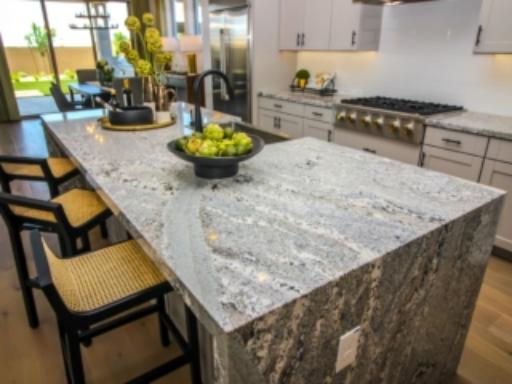Have you ever wondered how to create a stonewall kitchen design that will make your kitchen look cosy and rustic? A stonewall kitchen design is a kitchen design style that features natural stone as the main material for the walls, floors, or countertops. Stone is a versatile and durable material that can add character and charm to any kitchen. However, stone also comes in different types, colours, and patterns, each with advantages and disadvantages. Choosing the correct type of stone for your kitchen can be daunting, especially if you need to become more familiar with the properties and maintenance requirements of every kind of stone. I have written this blog post to help you learn more about stonewall kitchen design and the varieties of stones used. In this blog post, you will find:
- Some stunning examples of stonewall kitchen design that will inspire you to create your own.
- A detailed overview of the most common types of stones used in the kitchen and their characteristics, such as granite, quartz, marble, slate, limestone, and soapstone.
- Some tips and tricks on choosing and using stone in your kitchen include how to seal and clean gravel, mix and match different types of stone, and avoid common problems and mistakes.

By the end of this blog post, you will better understand stonewall kitchen design and the varieties of stones used. You can also create your own stonewall kitchen design that will suit your needs and preferences. So, without further ado, let’s get started!
Here are some stunning examples of how stone can create a cosy, rustic stonewall kitchen .
- This kitchen has a floor-to-ceiling stone wall behind a modern staircase, creating a dramatic contrast between the old and the new. The stonewall kitchen design adds texture and warmth to the space, while the sleek staircase and cabinets provide a contemporary touch.
- This kitchen has a stonewall kit backsplash that complements the wooden cabinets and countertops. The stone backsplash is easy to clean and adds a natural element to the kitchen. The stone tiles have different colours and patterns, giving the backsplash a unique look.
- This kitchen has a soapstone countertop that matches the grey cabinets and appliances. Soapstone is a non-porous and heat-resistant stone that is perfect for countertops. It has a soft and smooth texture that feels like soap. Soapstone also develops a patina over time, enhancing its beauty.
Types of Stones Used in Stonewall Kitchen Design
Many types of stones can be used for stonewall kitchen countertops design, flooring, or walls. Each type of stone has advantages and disadvantages, depending on your needs and preferences. Here are some of the most common stones used in stonewall kitchen design and their characteristics.
- Granite: Granite is one of the most popular and expensive stonewall kitchen countertops. It is a natural stone in a wide range of colours and patterns. Granite is resistant to heat and abrasion, making it solid and durable. However, granite is also porous and requires regular sealing to prevent stains and bacteria.

- Quartz: Quartz is an artificial stone that can mimic the look of natural stone, such as marble and granite. Quartz is available in many colours and patterns, allowing you to customize your kitchen design. Quartz is non-porous and does not need sealing, making it stain-resistant and hygienic. However, quartz is not heat-resistant and can crack under extreme temperatures.

- Marble: Marble is a natural stone known for its elegance and luxury. Marble has a smooth, shiny surface reflecting light and making the stonewall kitchen look brighter. Marble is also ideal for baking and making pasta, as it has a cold and smooth surface. However, marble is also a soft and porous stone that can easily scratch and stain. Marble also requires sealing and careful cleaning to maintain its beauty.

- Slate: Slate is a natural stone with a dense and dark appearance. Slate is perfect for countertops, as it is non-porous and heat-resistant. Slate also has a matte and textured surface that adds character to the kitchen. However, slate is a brittle stone that can chip and crack at the edges. Slate also needs to be oiled regularly to prevent fading and dullness.

- Limestone: Limestone is a natural stone with a light and earthy colour. Limestone is durable and heat-resistant, making it suitable for kitchen flooring. Limestone also has a subtle and natural pattern that adds charm to the kitchen. However, limestone is also a porous and soft stone that can scratch and stain easily. Limestone also requires sealing and gentle cleaning to preserve its look.

- Soapstone: Soapstone is a natural stone with a high percentage of talc, giving it a soft and soapy texture. Soapstone is non-porous and heat-resistant, making it an excellent choice for countertops. Soapstone also has a grey colour that can have blue or green undertones and marble-like veining. Soapstone also develops a patina over time, enhancing its appearance. However, soapstone is also a soft, pliable stone that can easily dent and scratch. Soapstone must also be treated with mineral oil regularly to keep its surface smooth and dark.

Conclusion
Stonewall kitchen design is a way to bring nature and history into your kitchen. Stone is a versatile and durable material that can create a cosy and rustic atmosphere in your kitchen. However, stone also has different properties and maintenance requirements that you need to consider before choosing the best type of stone for your kitchen. This blog post has given you some inspiration and information on creating your stonewall kitchen design. If you have any questions or comments, please leave them below. Thank you for reading!







